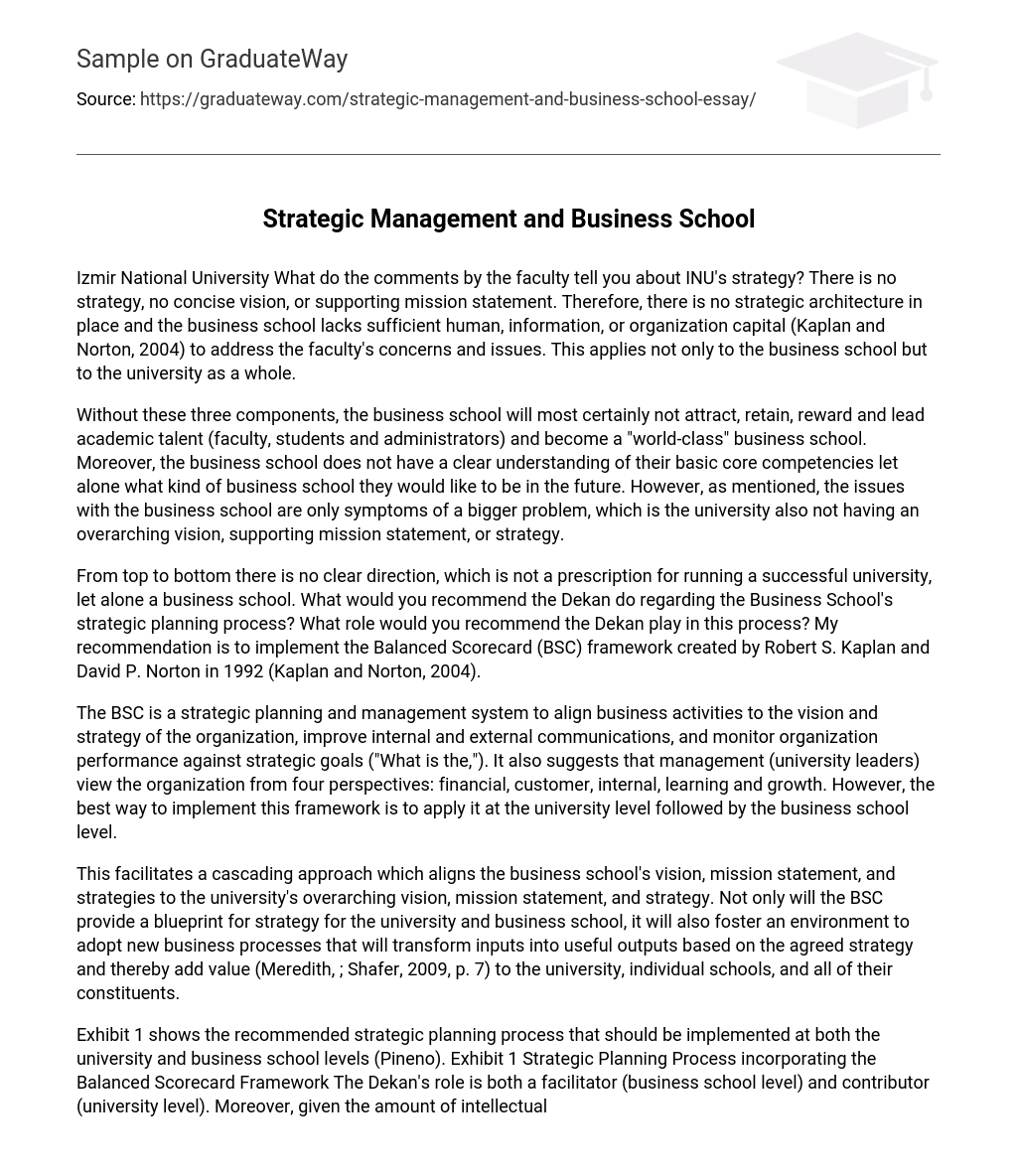Izmir National University What do the comments by the faculty tell you about INU’s strategy? There is no strategy, no concise vision, or supporting mission statement. Therefore, there is no strategic architecture in place and the business school lacks sufficient human, information, or organization capital (Kaplan and Norton, 2004) to address the faculty’s concerns and issues. This applies not only to the business school but to the university as a whole.
Without these three components, the business school will most certainly not attract, retain, reward and lead academic talent (faculty, students and administrators) and become a “world-class” business school. Moreover, the business school does not have a clear understanding of their basic core competencies let alone what kind of business school they would like to be in the future. However, as mentioned, the issues with the business school are only symptoms of a bigger problem, which is the university also not having an overarching vision, supporting mission statement, or strategy.
From top to bottom there is no clear direction, which is not a prescription for running a successful university, let alone a business school. What would you recommend the Dekan do regarding the Business School’s strategic planning process? What role would you recommend the Dekan play in this process? My recommendation is to implement the Balanced Scorecard (BSC) framework created by Robert S. Kaplan and David P. Norton in 1992 (Kaplan and Norton, 2004).
The BSC is a strategic planning and management system to align business activities to the vision and strategy of the organization, improve internal and external communications, and monitor organization performance against strategic goals (“What is the,”). It also suggests that management (university leaders) view the organization from four perspectives: financial, customer, internal, learning and growth. However, the best way to implement this framework is to apply it at the university level followed by the business school level.
This facilitates a cascading approach which aligns the business school’s vision, mission statement, and strategies to the university’s overarching vision, mission statement, and strategy. Not only will the BSC provide a blueprint for strategy for the university and business school, it will also foster an environment to adopt new business processes that will transform inputs into useful outputs based on the agreed strategy and thereby add value (Meredith, ; Shafer, 2009, p. 7) to the university, individual schools, and all of their constituents.
Exhibit 1 shows the recommended strategic planning process that should be implemented at both the university and business school levels (Pineno). Exhibit 1 Strategic Planning Process incorporating the Balanced Scorecard Framework The Dekan’s role is both a facilitator (business school level) and contributor (university level). Moreover, given the amount of intellectual capital within an academic institution, it is imperative that the docents, assistant docents, lecturers, professors, and administrators be included in the BSC strategic planning process.
A method the Dekan can use is the Virtuous Strategy Cycle (Martin, 2010). It is a framework that enables employees (faculty) to send information back upstream, improving the knowledge base of decision makers higher up and enabling everyone in the organization to contribute and make better choices (Martin, 2010). The employee is now not only the brain but also the arms and legs of the organization. He is both a chooser and a doer. Employees are made to feel empowered, and the whole organization wins.
How could the productivity of the Business School be measured? What would the effect be on productivity if the faculty received a 10 percent raise but continued to teach the same number of students? The BSC framework lays out nicely how productivity can be measured. Because the BSC is built around four perspectives (financial, customer, internal, learning and growth), productivity goals can easily be developed, classified, and measured for each perspective. Exhibit 2 shows how productivity can be measured utilizing the BSC framework (Pineno).
Exhibit 2 Productivity Measurement Utilizing the BSC Framework Financial Perspective| Goals| Measures| Fund raising| Size/growth of endowment| Revenue from operations| Tuition revenue growth| Customer Perspective| Retain high-quality students| Student satisfaction surveys| Faculty satisfaction and quality| Level of faculty publications/presentations| | | Internal Perspective| | Quality and currency of faculty| Teaching load policy management| Curriculum/program excellence| Higher education accreditations| | | | | Learning and Growth Perspective|
Faculty development| Number of ongoing instructional development programs| Quality of facilities| % of budget for improved facilities/information systems/telecommunications systems| From an operations management perspective, increasing an input (higher compensation) that results in the same or less output (number of students taught) is not necessarily creating value for the university. However, this depends on the university’s strategy. If the intent of the increased compensation was to motivate the university’s faculty to increase enrollment, then the higher compensation failed resulting in higher unit costs for the university.
Conversely, if enrollment capacity is sufficient and the intent was to motivate the faculty (input) to improve the graduation rate (output), then the higher compensation could potentially succeed if it met the university’s graduation rate goal. Therefore, value would be created for the university. The increase in compensation, even though the amount of students taught are the same, can only be determined based on the context of what the underlying strategy was to accomplish given an increase in compensation. References Kaplan, Robert, ; Norton, David. (2004). Strategy maps.
Harvard Business Press. Martin, R. (2010, July/August). Drawing a line between strategy and execution almost guarantees failure. Harvard Business Review, 64-71. Meredith, Jack, ; Shafer, Scott. (2009). Operations management for mbas. Wiley. Pineno, C. (n. d. ). The Business school strategy: continuous improvement by implementing the balanced scorecard . Retrieved from http://www. aabri. com/manuscripts/08016. pdf What is the balanced scorecard. (n. d. ). Retrieved from http://www. balancedscorecard. org/bscresources/aboutthebalancedscorecard/tabid/55/default. aspx





